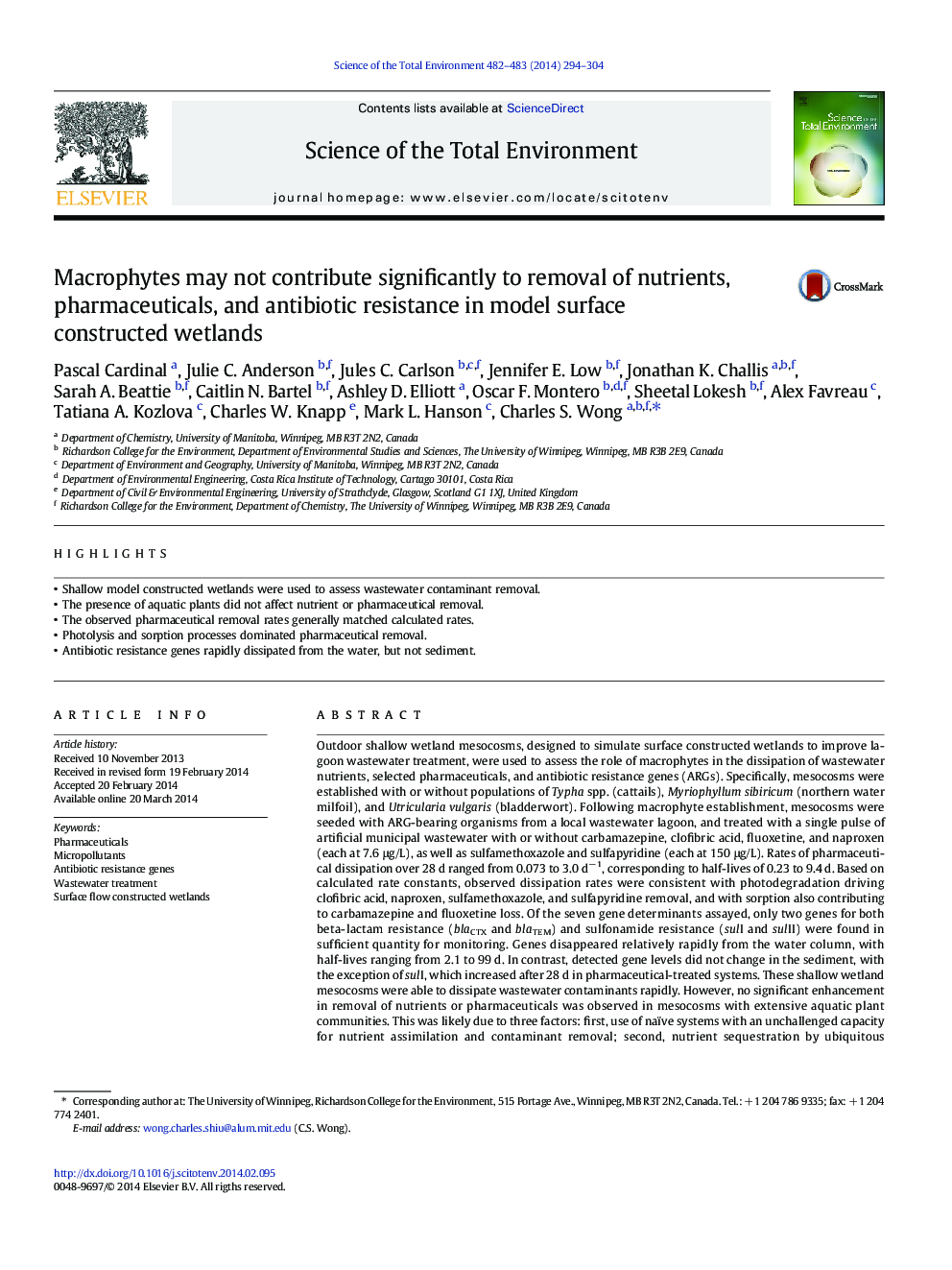| کد مقاله | کد نشریه | سال انتشار | مقاله انگلیسی | نسخه تمام متن |
|---|---|---|---|---|
| 6330756 | 1619785 | 2014 | 11 صفحه PDF | دانلود رایگان |
عنوان انگلیسی مقاله ISI
Macrophytes may not contribute significantly to removal of nutrients, pharmaceuticals, and antibiotic resistance in model surface constructed wetlands
ترجمه فارسی عنوان
ماکروفیدها ممکن است به حذف مواد مغذی، داروها و مقاومت آنتی بیوتیکی در سطح تالاب های ساخته شده در سطح مدل کمک قابل توجهی نداشته باشند
دانلود مقاله + سفارش ترجمه
دانلود مقاله ISI انگلیسی
رایگان برای ایرانیان
کلمات کلیدی
داروها، مخازن میکرو ژن های مقاومت آنتی بیوتیک، تصفیه فاضلاب، تالاب سطحی ساخته شده است،
موضوعات مرتبط
علوم زیستی و بیوفناوری
علوم محیط زیست
شیمی زیست محیطی
چکیده انگلیسی
Outdoor shallow wetland mesocosms, designed to simulate surface constructed wetlands to improve lagoon wastewater treatment, were used to assess the role of macrophytes in the dissipation of wastewater nutrients, selected pharmaceuticals, and antibiotic resistance genes (ARGs). Specifically, mesocosms were established with or without populations of Typha spp. (cattails), Myriophyllum sibiricum (northern water milfoil), and Utricularia vulgaris (bladderwort). Following macrophyte establishment, mesocosms were seeded with ARG-bearing organisms from a local wastewater lagoon, and treated with a single pulse of artificial municipal wastewater with or without carbamazepine, clofibric acid, fluoxetine, and naproxen (each at 7.6 μg/L), as well as sulfamethoxazole and sulfapyridine (each at 150 μg/L). Rates of pharmaceutical dissipation over 28 d ranged from 0.073 to 3.0 dâ 1, corresponding to half-lives of 0.23 to 9.4 d. Based on calculated rate constants, observed dissipation rates were consistent with photodegradation driving clofibric acid, naproxen, sulfamethoxazole, and sulfapyridine removal, and with sorption also contributing to carbamazepine and fluoxetine loss. Of the seven gene determinants assayed, only two genes for both beta-lactam resistance (blaCTX and blaTEM) and sulfonamide resistance (sulI and sulII) were found in sufficient quantity for monitoring. Genes disappeared relatively rapidly from the water column, with half-lives ranging from 2.1 to 99 d. In contrast, detected gene levels did not change in the sediment, with the exception of sulI, which increased after 28 d in pharmaceutical-treated systems. These shallow wetland mesocosms were able to dissipate wastewater contaminants rapidly. However, no significant enhancement in removal of nutrients or pharmaceuticals was observed in mesocosms with extensive aquatic plant communities. This was likely due to three factors: first, use of naïve systems with an unchallenged capacity for nutrient assimilation and contaminant removal; second, nutrient sequestration by ubiquitous filamentous algae; and third, dominance of photolytic processes in the removal of pharmaceuticals, which overshadowed putative plant-related processes.
ناشر
Database: Elsevier - ScienceDirect (ساینس دایرکت)
Journal: Science of The Total Environment - Volumes 482â483, 1 June 2014, Pages 294-304
Journal: Science of The Total Environment - Volumes 482â483, 1 June 2014, Pages 294-304
نویسندگان
Pascal Cardinal, Julie C. Anderson, Jules C. Carlson, Jennifer E. Low, Jonathan K. Challis, Sarah A. Beattie, Caitlin N. Bartel, Ashley D. Elliott, Oscar F. Montero, Sheetal Lokesh, Alex Favreau, Tatiana A. Kozlova, Charles W. Knapp, Mark L. Hanson,
